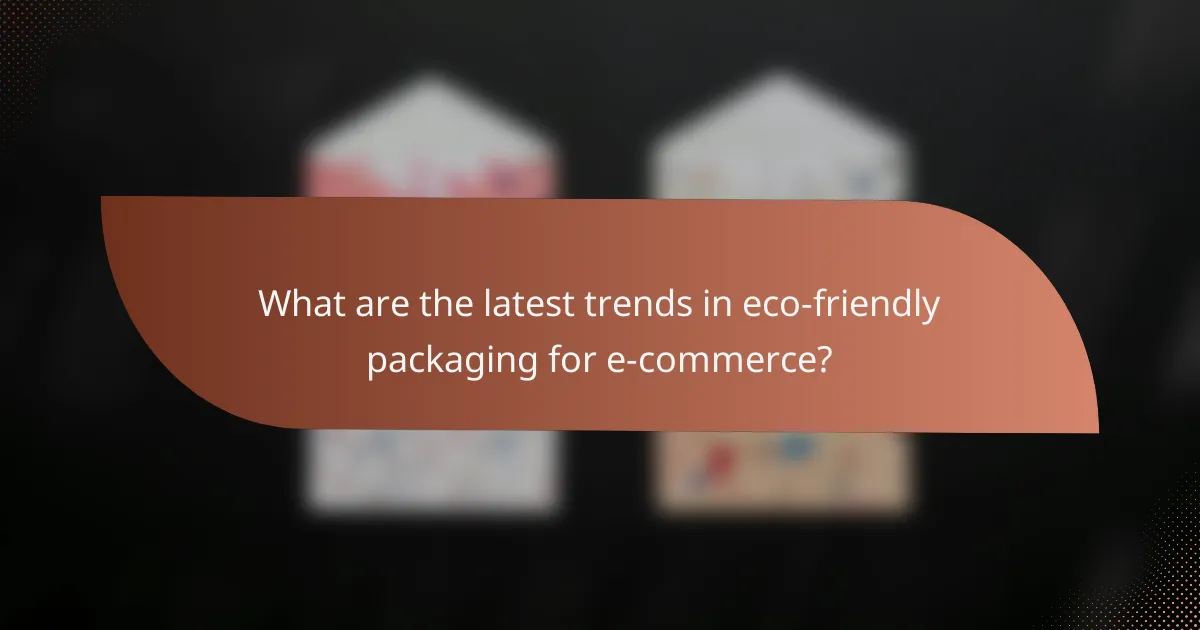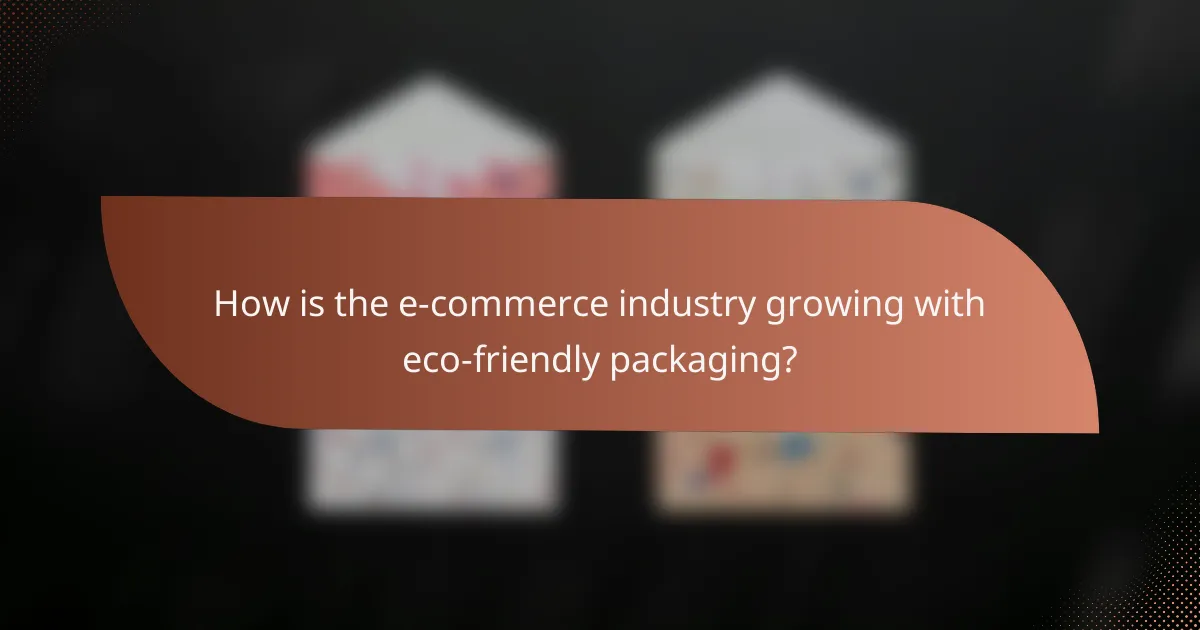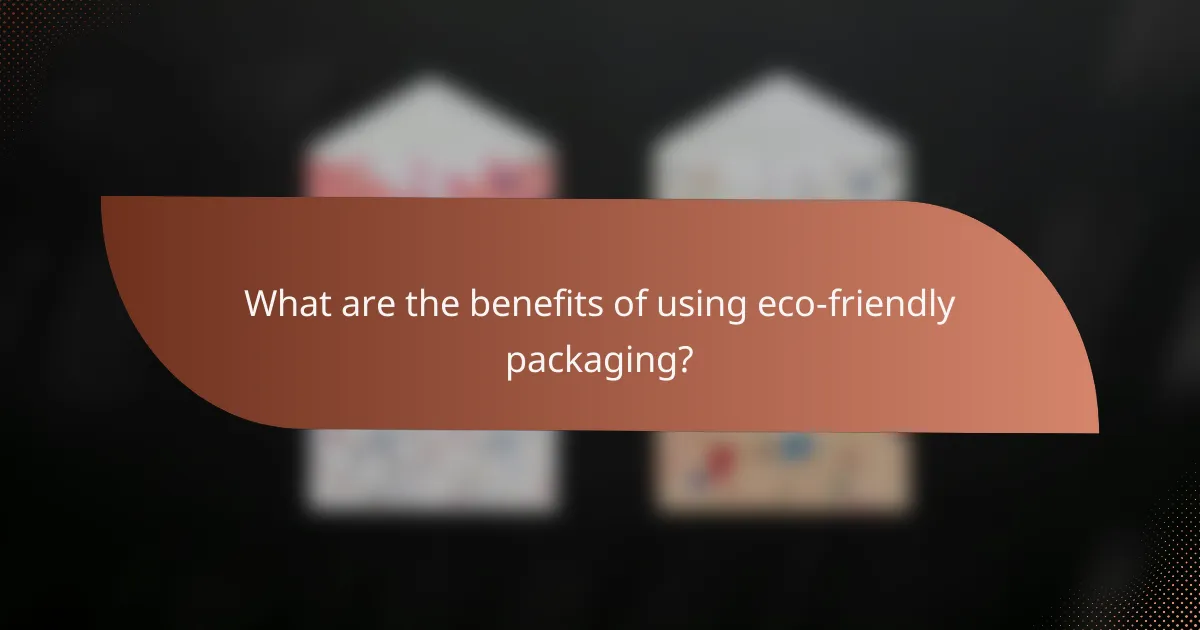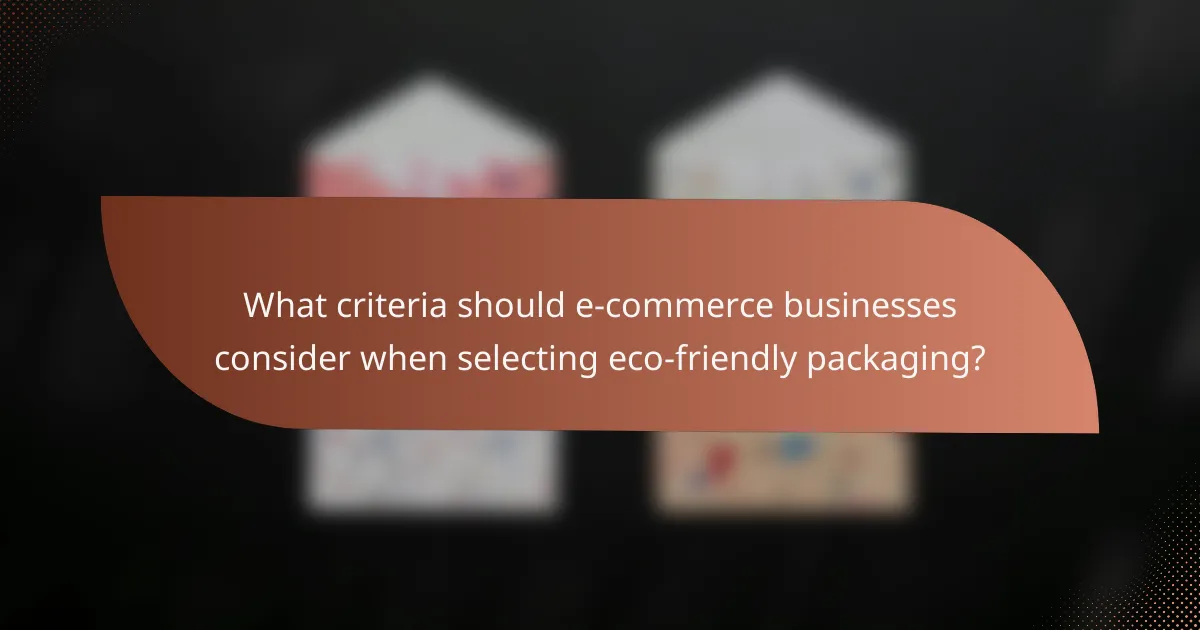The e-commerce sector is witnessing a significant shift towards eco-friendly packaging, driven by consumer demand for sustainability and innovative solutions. This trend not only reduces environmental impact but also fosters brand loyalty and enhances market competitiveness. By adopting sustainable materials and practices, companies can align with evolving regulations and contribute to a healthier planet while improving their brand image.

What are the latest trends in eco-friendly packaging for e-commerce?
Recent trends in eco-friendly packaging for e-commerce focus on sustainability, reducing waste, and enhancing consumer experience. Companies are increasingly adopting innovative materials and designs that minimize environmental impact while meeting customer expectations.
Biodegradable materials
Biodegradable materials are gaining traction as a sustainable alternative to traditional plastics. These materials break down naturally over time, reducing landfill waste. Common options include plant-based plastics, paper, and compostable films, which can be used for various packaging applications.
When selecting biodegradable options, consider the specific environmental conditions required for decomposition, as some materials may need industrial composting facilities to break down effectively.
Reusable packaging solutions
Reusable packaging solutions are becoming popular as they promote a circular economy. Businesses are implementing systems where customers can return packaging for reuse, reducing the need for single-use materials. Examples include durable boxes and containers that can be sent back for refills or repurposed.
To effectively implement reusable packaging, companies should establish clear return processes and incentivize customers to participate, such as offering discounts or loyalty points for returns.
Minimalist packaging designs
Minimalist packaging designs focus on reducing excess materials while maintaining product protection. This approach not only cuts costs but also appeals to eco-conscious consumers. Brands are opting for simple, elegant designs that use less ink and fewer materials.
When adopting minimalist designs, ensure that the packaging still meets shipping requirements and protects the product during transit. Consider using lightweight materials that provide adequate protection without unnecessary bulk.
Smart packaging technology
Smart packaging technology integrates digital features to enhance the consumer experience and improve sustainability. This includes QR codes for recycling information, sensors for tracking freshness, and materials that change color to indicate spoilage.
Investing in smart packaging can provide valuable data on consumer behavior and product performance, helping brands optimize their supply chain and reduce waste. However, consider the additional costs and technical requirements associated with implementing such technologies.
Consumer demand for sustainability
Consumer demand for sustainability is driving e-commerce businesses to adopt eco-friendly packaging solutions. Shoppers are increasingly seeking brands that prioritize environmental responsibility, often willing to pay a premium for sustainable options.
To meet this demand, companies should communicate their sustainability efforts clearly, highlighting the environmental benefits of their packaging choices. Engaging consumers through educational content about recycling and sustainability can further enhance brand loyalty.

How is the e-commerce industry growing with eco-friendly packaging?
The e-commerce industry is increasingly adopting eco-friendly packaging as a key strategy for growth. This shift not only meets consumer demand for sustainable practices but also enhances brand loyalty and market competitiveness.
Increased market share
Companies that implement eco-friendly packaging often see an increase in market share as consumers gravitate towards brands that prioritize sustainability. Research indicates that a significant portion of shoppers, especially younger demographics, prefer to purchase from environmentally responsible companies.
For example, brands that utilize biodegradable materials or recyclable packaging can differentiate themselves in a crowded market, leading to higher sales and customer retention rates. This trend is particularly strong in regions like Europe and North America, where environmental awareness is high.
Investment in sustainable materials
Investing in sustainable materials is crucial for e-commerce businesses looking to enhance their eco-friendly packaging. Options such as recycled paper, biodegradable plastics, and compostable materials are becoming more accessible and affordable.
Brands should consider the lifecycle impact of their packaging choices, including sourcing, production, and disposal. By prioritizing materials that reduce carbon footprints, companies can not only comply with regulations but also appeal to eco-conscious consumers.
Partnerships with eco-conscious brands
Forming partnerships with eco-conscious brands can amplify the impact of sustainable packaging initiatives. Collaborations can lead to shared resources, innovative solutions, and enhanced credibility in the eyes of consumers.
For instance, e-commerce platforms can team up with suppliers who specialize in sustainable packaging solutions, ensuring that their entire supply chain aligns with eco-friendly practices. These partnerships can also facilitate marketing efforts, as joint campaigns can highlight the commitment to sustainability, attracting more customers.

What are the benefits of using eco-friendly packaging?
Eco-friendly packaging offers several advantages, including reduced environmental harm, increased customer loyalty, and compliance with evolving regulations. By choosing sustainable materials, businesses can contribute to a healthier planet while enhancing their brand image.
Reduced environmental impact
Using eco-friendly packaging significantly lowers the negative effects on the environment. Materials like biodegradable plastics, recycled paper, and plant-based substances reduce waste and pollution. Companies can minimize their carbon footprint by opting for packaging that is either recyclable or compostable.
For example, brands that use recycled materials can decrease the demand for virgin resources, which helps preserve natural habitats. Additionally, lightweight packaging can reduce transportation emissions, making logistics more efficient.
Enhanced brand loyalty
Consumers are increasingly favoring brands that demonstrate a commitment to sustainability. By adopting eco-friendly packaging, businesses can attract environmentally conscious customers and foster brand loyalty. This approach not only differentiates a brand in a crowded market but also encourages repeat purchases.
Promoting sustainable practices through packaging can resonate with customers, leading to positive word-of-mouth and increased customer retention. Brands that communicate their eco-friendly initiatives effectively often see a boost in their reputation and customer trust.
Compliance with regulations
As environmental concerns grow, many countries are implementing stricter regulations regarding packaging waste. Using eco-friendly packaging helps businesses stay compliant with these laws, avoiding potential fines and legal issues. Regulations may include bans on single-use plastics or requirements for recyclable materials.
Staying ahead of regulatory changes can provide a competitive advantage. Companies that proactively adopt sustainable practices are better positioned to adapt to new laws, ensuring they remain compliant and relevant in the marketplace.

What are the challenges faced by e-commerce businesses in adopting eco-friendly packaging?
E-commerce businesses encounter several challenges when adopting eco-friendly packaging, including higher costs, supply chain complexities, and the need for consumer education. These factors can hinder the transition to sustainable practices while also impacting profitability and customer engagement.
Higher costs of sustainable materials
The use of sustainable materials often comes with higher upfront costs compared to traditional packaging options. For instance, biodegradable plastics or recycled paper may be more expensive, which can squeeze profit margins for e-commerce companies. Businesses must weigh the long-term benefits of sustainability against these immediate financial impacts.
To mitigate costs, companies can explore bulk purchasing agreements or partnerships with suppliers specializing in eco-friendly materials. Additionally, investing in innovative packaging solutions that reduce material usage can help offset expenses over time.
Supply chain complexities
Integrating eco-friendly packaging into existing supply chains can introduce complexities, such as sourcing sustainable materials and ensuring they meet quality standards. E-commerce businesses may face challenges in finding reliable suppliers who can provide consistent, sustainable options without disrupting their logistics.
It is crucial for companies to develop strong relationships with suppliers and to conduct thorough research on the sustainability credentials of their materials. Implementing a flexible supply chain strategy can help businesses adapt to changes in availability and demand for eco-friendly packaging.
Consumer education and awareness
Many consumers are still unaware of the benefits of eco-friendly packaging, which can affect their purchasing decisions. E-commerce businesses need to actively educate their customers about the environmental impact of packaging choices and the advantages of sustainable options.
Effective strategies include clear labeling of eco-friendly products, informative content on websites, and engaging marketing campaigns that highlight sustainability efforts. By fostering consumer awareness, businesses can not only enhance brand loyalty but also drive demand for eco-friendly packaging solutions.

What criteria should e-commerce businesses consider when selecting eco-friendly packaging?
E-commerce businesses should prioritize material sustainability, cost-effectiveness, and supplier reliability when selecting eco-friendly packaging. These criteria ensure that packaging choices align with environmental goals while remaining practical and economically viable.
Material sustainability
Material sustainability refers to using packaging materials that are renewable, recyclable, or biodegradable. Businesses should look for options like recycled paper, biodegradable plastics, or plant-based materials that minimize environmental impact.
Consider certifications such as FSC (Forest Stewardship Council) for paper products or compostability standards like ASTM D6400. These certifications help in verifying the sustainability claims of the materials used.
Cost-effectiveness
Cost-effectiveness is crucial for e-commerce businesses aiming to maintain profitability while adopting eco-friendly practices. While sustainable materials may have a higher upfront cost, they can lead to savings through reduced waste disposal fees and potential tax incentives.
Evaluate the total cost of ownership, including shipping and storage, as lighter and more compact packaging can lower shipping costs. Comparing prices from multiple suppliers can also help identify the best value.
Supplier reliability
Supplier reliability ensures that businesses can consistently source eco-friendly packaging materials without disruptions. It is essential to assess suppliers based on their production capabilities, delivery timelines, and quality assurance processes.
Establishing long-term relationships with suppliers who prioritize sustainability can lead to better pricing and more innovative packaging solutions. Regular communication and performance reviews can help maintain a reliable supply chain.
